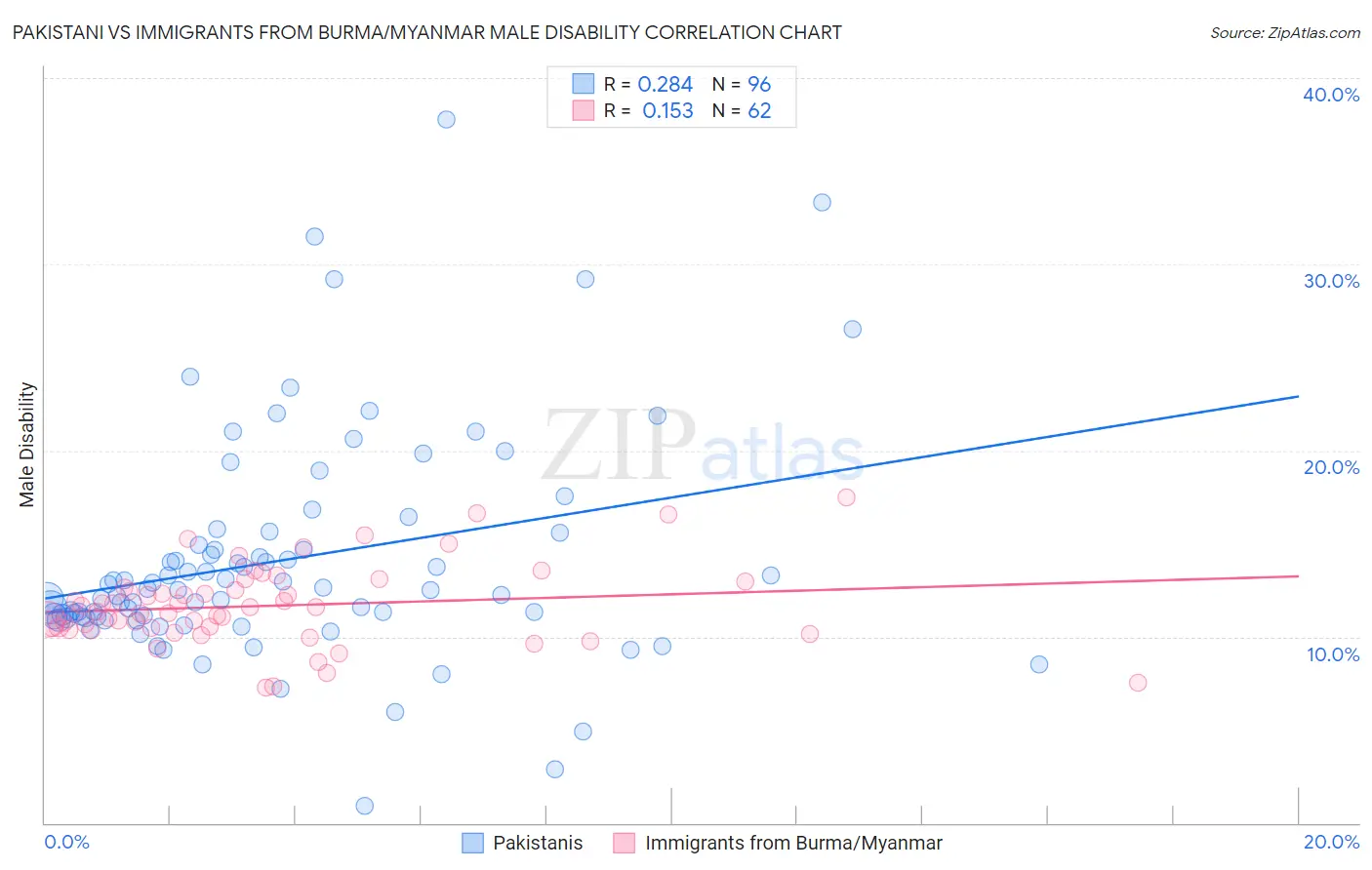Pakistani vs Immigrants from Burma/Myanmar Male Disability
COMPARE
Pakistani
Immigrants from Burma/Myanmar
Male Disability
Male Disability Comparison
Pakistanis
Immigrants from Burma/Myanmar
11.3%
MALE DISABILITY
30.3/ 100
METRIC RATING
185th/ 347
METRIC RANK
11.2%
MALE DISABILITY
50.4/ 100
METRIC RATING
173rd/ 347
METRIC RANK
Pakistani vs Immigrants from Burma/Myanmar Male Disability Correlation Chart
The statistical analysis conducted on geographies consisting of 335,283,610 people shows a weak positive correlation between the proportion of Pakistanis and percentage of males with a disability in the United States with a correlation coefficient (R) of 0.284 and weighted average of 11.3%. Similarly, the statistical analysis conducted on geographies consisting of 172,332,425 people shows a poor positive correlation between the proportion of Immigrants from Burma/Myanmar and percentage of males with a disability in the United States with a correlation coefficient (R) of 0.153 and weighted average of 11.2%, a difference of 1.2%.

Male Disability Correlation Summary
| Measurement | Pakistani | Immigrants from Burma/Myanmar |
| Minimum | 0.92% | 7.3% |
| Maximum | 37.8% | 17.5% |
| Range | 36.8% | 10.2% |
| Mean | 14.1% | 11.7% |
| Median | 12.5% | 11.4% |
| Interquartile 25% (IQ1) | 11.0% | 10.5% |
| Interquartile 75% (IQ3) | 15.2% | 12.6% |
| Interquartile Range (IQR) | 4.2% | 2.1% |
| Standard Deviation (Sample) | 6.1% | 2.2% |
| Standard Deviation (Population) | 6.0% | 2.1% |
Demographics Similar to Pakistanis and Immigrants from Burma/Myanmar by Male Disability
In terms of male disability, the demographic groups most similar to Pakistanis are Iraqi (11.3%, a difference of 0.010%), Immigrants from Central America (11.3%, a difference of 0.16%), Immigrants from Zaire (11.4%, a difference of 0.18%), Immigrants from Austria (11.4%, a difference of 0.20%), and Immigrants from Belize (11.3%, a difference of 0.21%). Similarly, the demographic groups most similar to Immigrants from Burma/Myanmar are Romanian (11.2%, a difference of 0.020%), Maltese (11.2%, a difference of 0.020%), Immigrants from Honduras (11.2%, a difference of 0.10%), Haitian (11.2%, a difference of 0.12%), and New Zealander (11.2%, a difference of 0.14%).
| Demographics | Rating | Rank | Male Disability |
| Barbadians | 53.4 /100 | #169 | Average 11.2% |
| New Zealanders | 52.9 /100 | #170 | Average 11.2% |
| Haitians | 52.5 /100 | #171 | Average 11.2% |
| Romanians | 50.7 /100 | #172 | Average 11.2% |
| Immigrants | Burma/Myanmar | 50.4 /100 | #173 | Average 11.2% |
| Maltese | 50.0 /100 | #174 | Average 11.2% |
| Immigrants | Honduras | 48.7 /100 | #175 | Average 11.2% |
| Syrians | 46.6 /100 | #176 | Average 11.2% |
| Immigrants | Norway | 44.2 /100 | #177 | Average 11.3% |
| Australians | 42.2 /100 | #178 | Average 11.3% |
| Immigrants | Caribbean | 41.4 /100 | #179 | Average 11.3% |
| Hondurans | 41.1 /100 | #180 | Average 11.3% |
| Immigrants | Senegal | 34.4 /100 | #181 | Fair 11.3% |
| Immigrants | Belize | 33.7 /100 | #182 | Fair 11.3% |
| Immigrants | Central America | 32.9 /100 | #183 | Fair 11.3% |
| Iraqis | 30.5 /100 | #184 | Fair 11.3% |
| Pakistanis | 30.3 /100 | #185 | Fair 11.3% |
| Immigrants | Zaire | 27.6 /100 | #186 | Fair 11.4% |
| Immigrants | Austria | 27.3 /100 | #187 | Fair 11.4% |
| Estonians | 26.8 /100 | #188 | Fair 11.4% |
| Immigrants | Netherlands | 25.9 /100 | #189 | Fair 11.4% |